Developer Guide
- 1. Introduction
- 2. Setting up, getting started
- 3. Design
- 4. Implementation
- 5. Documentation, logging, testing, configuration, dev-ops
- Appendix A: Product Scope
- Appendix B: User Stories
- Appendix C: Use Cases
- Appendix D: Non-Functional Requirements
- Appendix E: Glossary
- Appendix F: Instructions for Manual Testing
- Appendix G: Effort
1. Introduction
TrackPad is an app for users to create and store itineraries, to facilitate the planning of their dream vacation! This document includes the various design choices, architecture and implementation features of TrackPad. This document is targeted towards developers who want to contribute to and extend our TrackPad app.
2. Setting up, getting started
Follow the link to set up your environment and get started in creating pull requests for TrackPad.
3. Design
This section discusses the current design pattern used by TrackPad. It explains the current architecture of TrackPad. Then, there is a more in depth explanation on the design of the Ui, model and storage functionality.
3.1 Architecture

Figure 1 explains the high-level design of the App. Given below is a quick overview of each component.
.puml files used to create diagrams in this document can be found in the diagrams folder. Refer to the PlantUML Tutorial at se-edu/guides to learn how to create and edit diagrams.
Main has two classes called Main and MainApp. It is responsible for,
- At app launch: Initializes the components in the correct sequence, and connects them up with each other.
- At shut down: Shuts down the components and invokes cleanup methods where necessary.
Commons represents a collection of classes used by multiple other components.
The rest of the App consists of four components.
-
UI: The UI of the App. -
Logic: The command executor. -
Model: Holds the data of the App in memory. -
Storage: Reads data from, and writes data to, the hard disk.
Each of the four components,
- defines its API in an
interfacewith the same name as the Component. - exposes its functionality using a concrete
{Component Name}Managerclass (which implements the corresponding APIinterfacementioned in the previous point.

For example, the Logic component (seen from Figure 2 above) defines its API in the Logic.java interface and exposes its functionality using the LogicManager.java class which implements the Logic interface.
How the architecture components interact with each other

Figure 3 above shows how the components interact with each other for the scenario where the user issues the command delete-attraction 1.
The sections below give more details of each component.
3.2 UI

API :
Ui.java
The UI consists of a MainWindow that is made up of parts e.g.CommandBox, ResultDisplay, AttractionListPanel, ItineraryListPanel etc. All these, including the MainWindow, inherit from the abstract UiPart class.
The UI component uses JavaFx UI framework. The layout of these UI parts are defined in matching .fxml files that are in the src/main/resources/view folder. For example, the layout of the MainWindow is specified in MainWindow.fxml
The UI component,
- Executes user commands using the
Logiccomponent. - Listens for changes to
Modeldata so that the UI can be updated with the modified data.
This design is similar to the Architectural design of TrackPad, whereby different UiParts are encapsulated in the MainWindow java controller class. This allows the Logic to minimise interaction with the UI, since the MainWindow manages the changes to any UiPart classes that result from the execution in the Logic component.
3.3 Logic

API :
Logic.java
-
Logicin Figure 5 receives the user command. - It uses the
TrackPadParserclass to parse the command. - This results in a
Commandobject which is executed by theLogicManager. - The command execution can affect the
Model(e.g. adding an attraction). - The result of the command execution is encapsulated as a
CommandResultobject which is passed back to theUi. - In addition, the
CommandResultobject can also instruct theUito perform certain actions, such as displaying help to the user.
Given below is the Sequence Diagram for interactions within the Logic component for the execute("delete-attraction 1") API call.
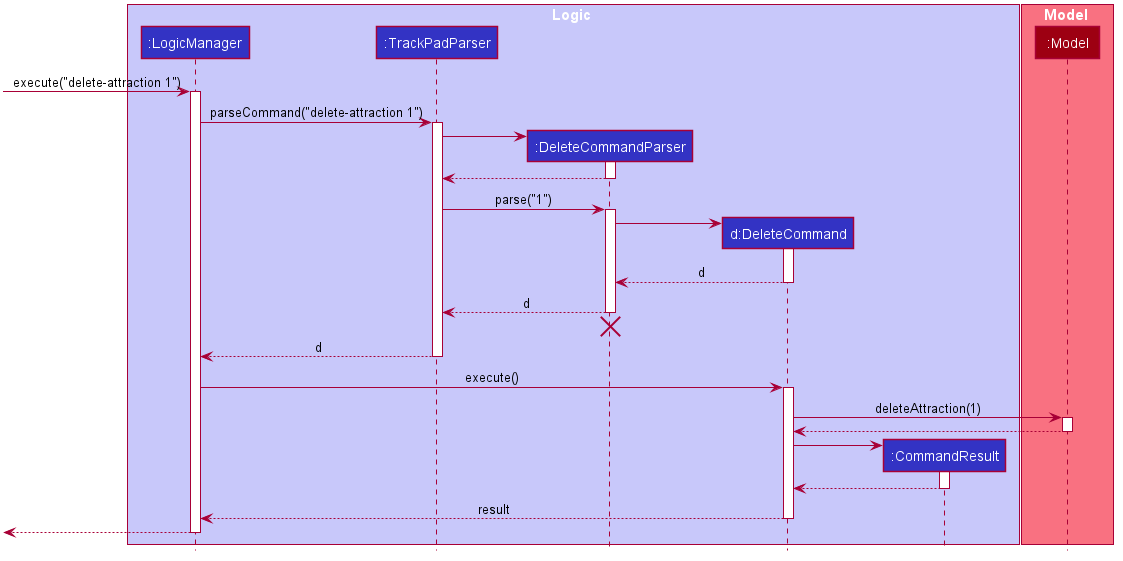
delete-attraction 1 CommandDeleteCommandParser should end at the destroy marker (X) but due to a limitation of PlantUML, the lifeline reaches the end of diagram.
3.4 Model

API : Model.java
The Model component shown in Figure 7,
- stores a
UserPrefobject that represents the user’s preferences. - stores an
AttractionListobject that is a list of all the attractions in TrackPad. - stores an
ItineraryListobject that is a list of all the itineraries in TrackPad. - stores an
ItineraryAttractionListobject that is a list of all the attractions in the current selected itinerary. - exposes two unmodifiable
ObservableList<Attraction>andObservableList<Itinerary>that can be ‘observed’ e.g. the UI can be bound to the lists so that the UI automatically updates when the data in the lists change. - does not depend on any of the other three components.
Tag list in the TrackPad, which Attraction references. This allows TrackPad to only require one Tag object per unique Tag, instead of each Attraction needing their own Tag object.
3.5 Storage

API : Storage.java
The Storage component shown in Figure 9,
- saves
UserPrefobjects containing user preferences in json format and read it back. - saves
AttractionListobjects containing attraction data in json format and read it back. - saves
ItineraryListobjects containing itinerary data in json format and read it back.
3.6 Common classes
Classes used by multiple components are in the seedu.address.commons package.
4. Implementation
This section describes some noteworthy details on the implementation of some core TrackPad features.
4.1 Attraction Model
4.1.1 Current Implementation
The Attraction class helps users to keep track of all the details of their tourist attractions added in TrackPad.
The class diagram for Attraction is shown below:

Each Attraction contains the following fields: Name, Description, Address, Email, Location, OpeningHours,
Phone, PriceRange, Rating, Visited and Tag. Only Name and Location are compulsory fields, the rest are all optional.
An attraction can have any number of Tags.
4.1.2 Design Considerations
Aspect: How attractions are determined to be the same as another
-
Alternative 1: Compare the
Name,PhoneandEmailof the attractions and 2 attractions are the same if all 3 fields are equal.- Pros: Do not need to change the implementation which was given to us by AddressBook3.
- Cons: The fields
PhoneandEmailare optional, so the basis for comparison is inconsistent as it depends on how many fields are provided for each attraction in TrackPad.
-
Alternative 2 (Current Choice): Compare the
NameandLocationof the attractions and 2 attractions are the same if both fields are equal.- Pros:
NameandLocationare the only fields which are compulsory, so comparing them will provide consistent results as all the attractions in TrackPad have these 2 fields filled up. - Cons:
NameandLocationare case-sensitive, so comparing attractions with the same name/location with different cases will result in the attractions to be determined as different attractions, which might not be ideal.
- Pros:
Reason for choosing Alternative 2: Our team decided to modify the existing code to suit our current implementation of the fields better, rather than just leaving it as it is.
4.2 Add Attraction Feature
The add attraction feature allows users to add attractions with the compulsory fields Name and Location, and
the optional fields Description, Address, Email, OpeningHours, Phone, PriceRange, Rating, Visited and Tag.
4.2.1 Current Implementation
Step 1. The user launches the application.
Step 2. The user types in add-attraction n/River Safari l/Singapore a/80 Mandai Lake Rd to add a new attraction. This attraction does not already exist in the app.
Step 3. LogicManager passes the input to TrackPadParser, which in turn recognises the input as an AddAttractionCommand and passes the input to AddAttractionCommandParser.
Step 4. AddAttractionCommandParser parses the input and constructs a new AddAttractionCommand containing a new Attraction with the specified fields.
Step 5. LogicManager executes the new AddAttractionCommand. This calls Model to add the new Attraction to its AttractionList.
Step 6. After the new Attraction is successfully added, AddAttractionCommand returns a CommandResult for the Ui to display.
The following sequence diagram shows how the add-attraction operation works:
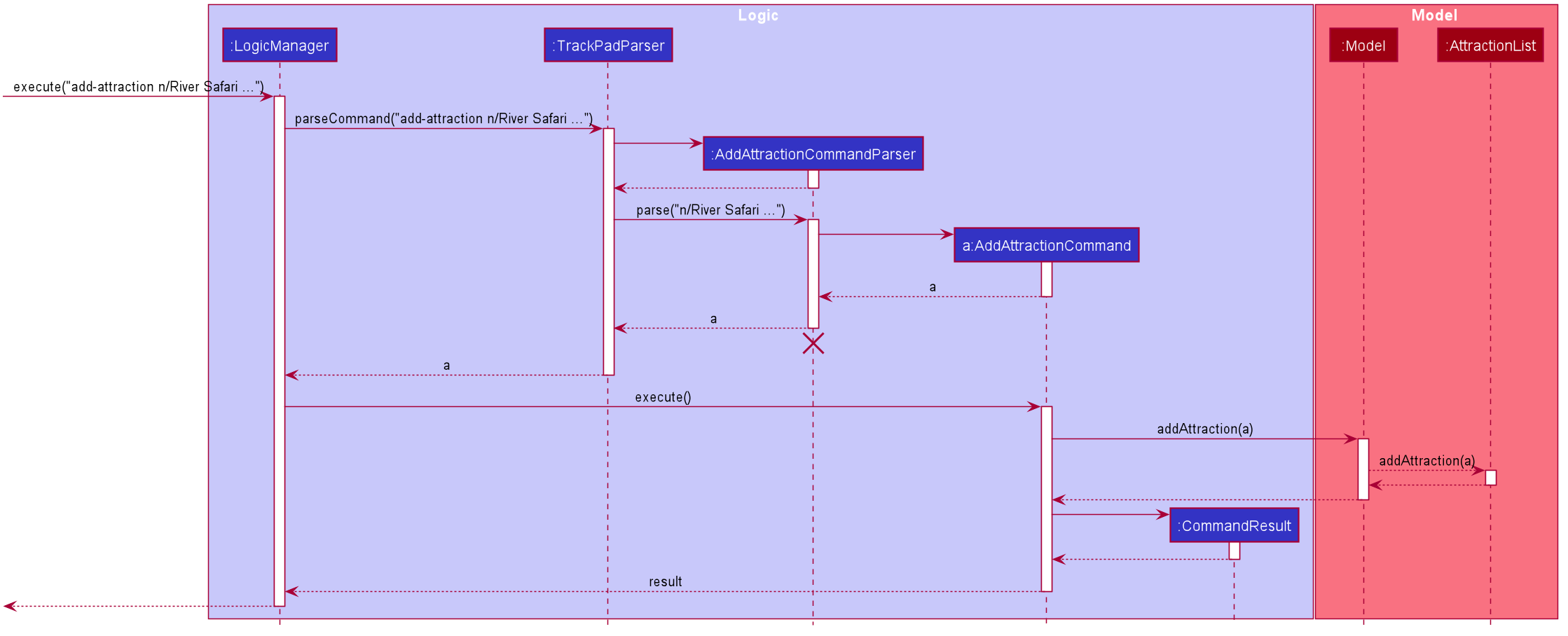
add-attraction4.2.2 Design Considerations
Aspect: How the command word of AddAttractionCommand is derived
-
Alternative 1: add-a
- Pros: Simple and short. The user will spend less time typing this command into the command box.
- Cons: Less intuitive, and the user will have to remember this specific command everytime he wants to add an attraction.
-
Alternative 2 (Current choice): add-attraction
- Pros: More intuitive, so the user is more likely to get the correct command everytime when adding attractions.
- Cons: The user will have to spend more time typing this command.
Reason for choosing Alternative 2: Given that our target audience are fast typists, a slightly longer word may not require a longer typing time after the users are used to typing this command in the long run.
4.3 Mark Attraction as Visited Feature
The markVisited-attraction command allows users to quickly mark attractions as visited, without having to use the edit-attraction command.
This command is implemented as it allows users to quickly and conveniently mark the attractions they have visited, so they can focus on visiting other attractions that they have not visited.
4.3.1 Current Implementation
The current implementation allows the users to mark the attraction as visited, based on its index position in the current attraction list.
This index could be different depending whether the whole attraction list is shown, or the filtered attraction list from the find-attraction command is currently shown in the GUI.
If the index is invalid or the attraction has already been visited before, an error message will be displayed and there will be no changes to the attraction list.
The following activity diagram shows how markVisited-attraction works:
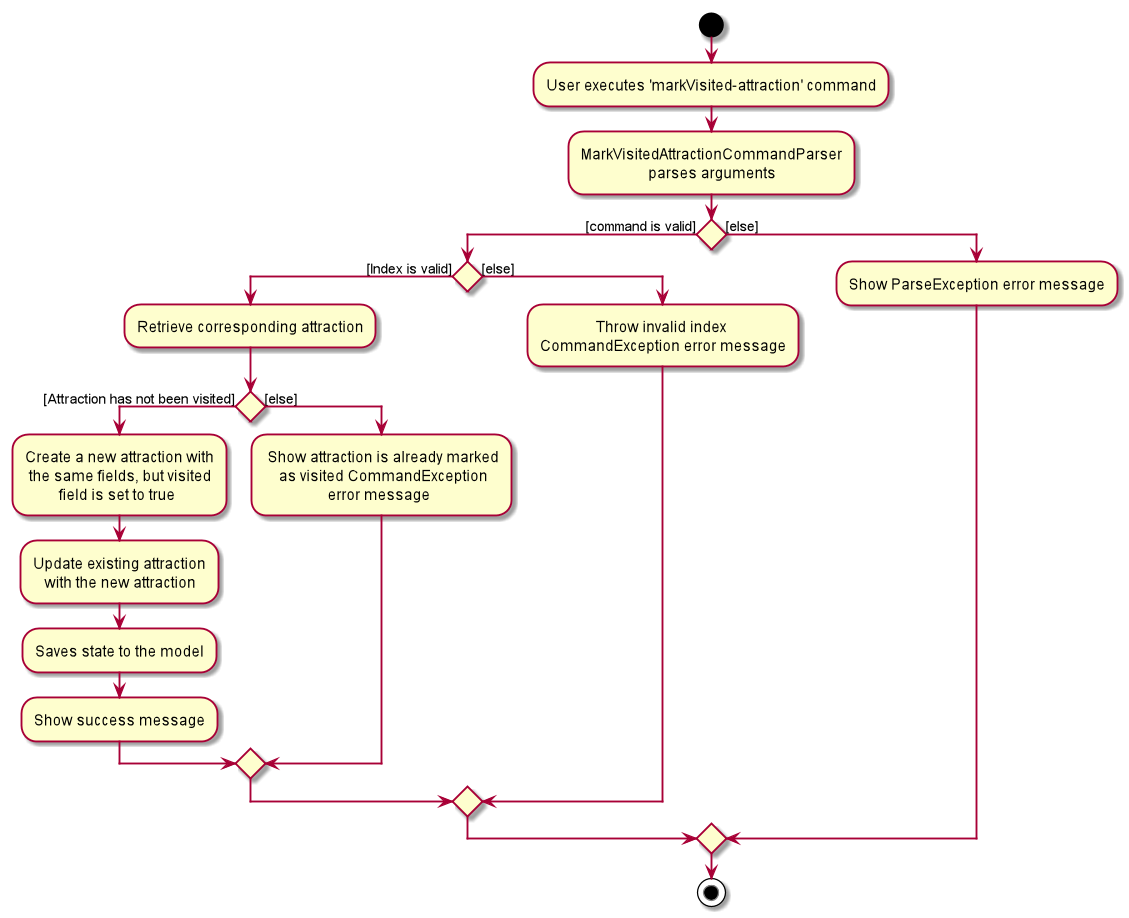
markVisited-attractionWe will use the above activity diagram as shown in Figure 12 to explain how the markVisited-attraction command is executed in detail.
We assume no error is encountered, and the attraction that is selected to be marked as visited is not visited yet.
Step 1. The user types in markVisited-attraction 1.
Step 2. MarkVisitedCommand is created.
Step 3. MarkVisitedCommand executes the getFilteredAttractionList() and returns lastShownList.
Step 4. Model then executes get(index) which creates Attraction, which is the original selected attraction in lastShownList.
Step 5. MarkVisitedCommand then executes createMarkVisitedAttraction(), which creates a new Attraction that is identical to the original attraction, except its Visited field is set to true.
Step 6. MarkVisitedCommand then sets the original attraction to the updated one, via setAttraction(), and it also updates the state of the model with updateFilteredAttractionList().
Step 7. MarkVisitedCommand then creates a new CommandResult, which contains the success message that is shown to the user when the command is executed successfully.
The whole sequence of events is outlined in the sequence diagram shown below.
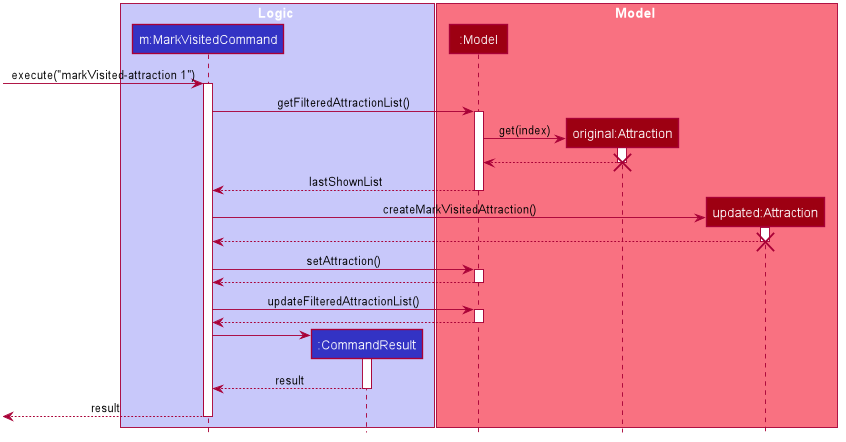
markVisited-attraction 14.3.2 Design Considerations
Aspect: How the attraction is updated
-
Alternative 1: Use the
edit-attractioncommand to handle marking the attraction as visited, since it can also edit theVisitedfield. - Pros: Less new code will need to be written, since we can reuse most of the code from
edit-attraction. -
Cons: Functionality of
markVisited-attractioncould change ifedit-attractionchanges functionality in a future update. Excessive coupling. -
Alternative 2 (Current Choice): Create a new
markVisited-attractioncommand and parser to handle specifically this command. - Pros: Less inputs for the user, which makes the command shorter and more convenient.
- Cons: More lines of code. More test cases required.
Reason for choosing alternative 2: Easier to extend to marking several attractions in one command in a future version, by inputting several indexes at once. This would be complicated to
handle within edit-attraction since each attraction could be edited in several fields, and the user input would become unnecessarily complicated.
4.4 Itinerary Model
4.4.1 Current Implementation
The Itinerary class helps users keep track of the details of their trips and the attractions they want to visit.
The class diagram for Itinerary is shown below:

Each Itinerary contains Name, Description, Budget, startDate and endDate. Both startDate and endDate
are of the ItineraryDate class. Additionally, to store the attractions that users want to visit, each Itinerary
contains a list of Days, and each Day contains a list of ItineraryAttractions that belong to that day.
4.4.2 Design Considerations
Aspect: How the location field of Itinerary is derived
-
Alternative 1: Have a field for location that the user has to manually specify alongside
Name,startDate,endDateetc.- Pros: Simple and intuitive for the user to specify.
- Cons: Would not update accordingly if the user adds attractions that are not in the specified location. It would also get complicated for the user to add and edit multiple locations in a certain order.
-
Alternative 2 (Current choice): Get the locations from the current
ItineraryAttractions in theItinerary.- Pros: The user neither has to worry about adding, editing and deleting locations, nor making sure they are correct order as it is done automatically.
- Cons: The itinerary would not have any specified locations unless the user adds an
ItineraryAttraction, which might not be intuitive to users.
Reason for choosing Alternative 2: If we were to go with Alternative 1, we would have to provide additional ways for users visiting multiple locations to change the order of the locations they are visiting, and possibly provide checks to ensure that the locations of attractions that users want to add into an itinerary matches the locations of the itinerary. We believe that this would be a more frustrating experience for users. Therefore, we decided on generating locations automatically from the itinerary attractions that the users have added to their itineraries instead.
Aspect: How ItineraryAttractions are stored with their visiting days
-
Alternative 1: Have
day visitingas a field inItineraryAttraction, together with its other fields likestartTime,endTimeetc. Then, haveItinerarydirectly store theItineraryAttractions.- Pros: Simple to implement and specify.
- Cons: Harder to separate the
ItineraryAttractions into the different days. More checks needed to display the correctItineraryAttractions in the correct days.
-
Alternative 2 (Current choice): Store
ItineraryAttractions in separateDays inItinerary, without having aday visitingfield forItineraryAttraction.- Pros:
ItineraryAttractions are clearly divided into the different days. Easier to get theItineraryAttractions on a specific day. - Cons: More methods and classes needed, which complicates things.
- Pros:
Reason for choosing Alternative 2: Since we are creating itineraries that have their contained itinerary attractions separated by day, we think that it will be easier to do so if the itinerary attractions are in their respective days. If not, any time we need to get itinerary attractions by days, some sorting or checking would be needed.
4.5 Add Itinerary Feature
The add-itinerary command allows users to add new itineraries into TrackPad.
To add an Itinerary, users must specify the compulsory fields Name, startDate and endDate, and may specify the optional fields Description and Budget.
4.5.1 Current Implementation
The AddItineraryCommand class handles the execution of add-itinerary operations. The AddItineraryCommandParser class helps to parse user inputs
into new AddItineraryCommands for execution.
Itineraries with the same Name, startDate and endDate are considered duplicates, and cannot be added if a duplicate already exists in the app.
If the user tries to add a duplicate itinerary, a CommandException will be thrown, and the user will be reminded that the itinerary already exists in the app.
Additionally, the startDate cannot be after the endDate. If the user attempts to add an itinerary with startDate after the endDate,
a ParseException will be thrown to remind the user of the date constraints.
The following steps illustrate the successful execution of an add-itinerary command:
Step 1. The user launches the application.
Step 2. The user types in add-itinerary n/Japan Trip sd/12-12-2020 ed/18-12-2020 d/fun in Japan b/1000 to add a new itinerary. This itinerary does not already exist in the app.
Step 3. LogicManager passes the input to TrackPadParser, which in turn recognises the input as an AddItineraryCommand and passes the input to AddItineraryCommandParser.
Step 4. AddItineraryCommandParser parses the input and constructs a new AddItineraryCommand containing a new Itinerary with the specified fields.
Step 5. LogicManager executes the new AddItineraryCommand. This calls Model to add the new Itinerary to its ItineraryList.
Step 6. After the new Itinerary is successfully added, AddItineraryCommand returns a CommandResult for the Ui to display.
The following sequence diagram shows how the add-itinerary operation above works:
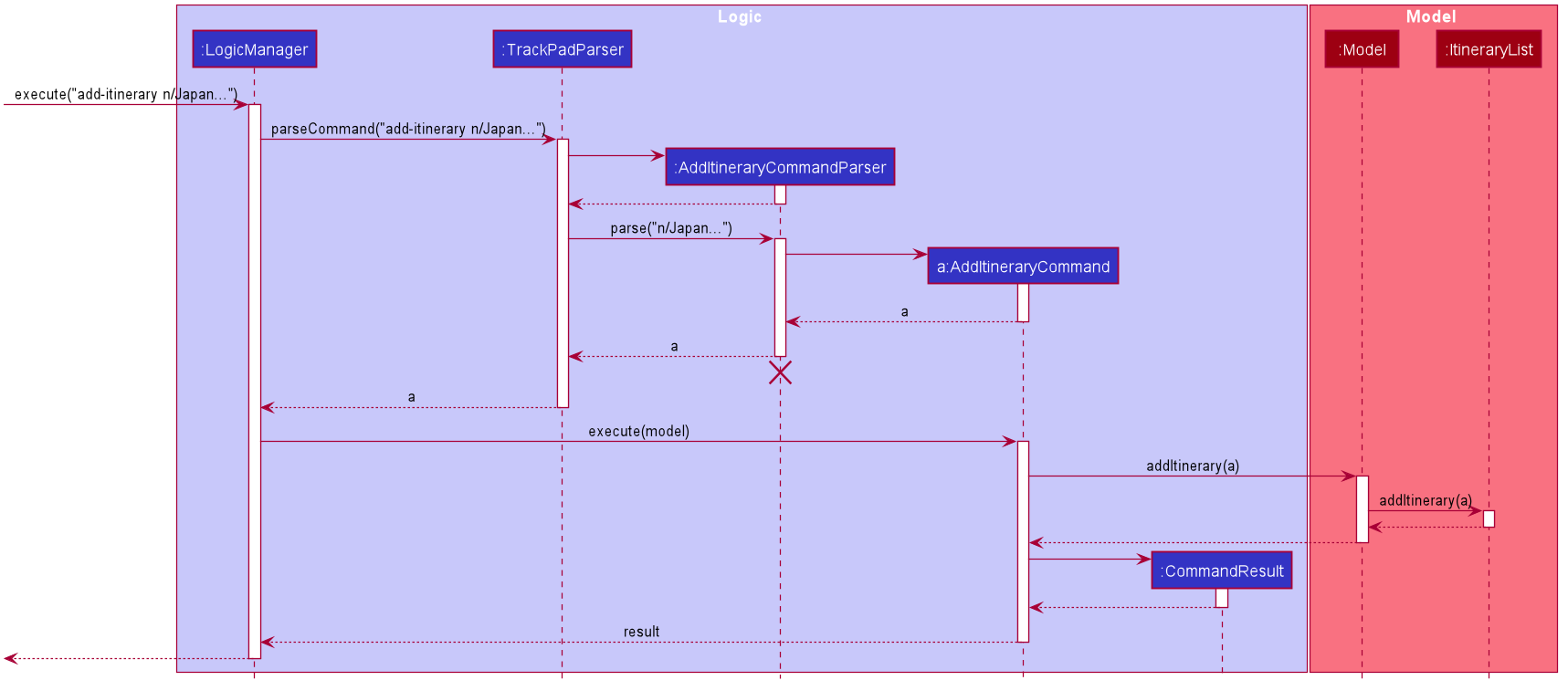
add-itineraryTo summarise, the following activity diagram shows what happens when a user executes an add-itinerary command, including errors:
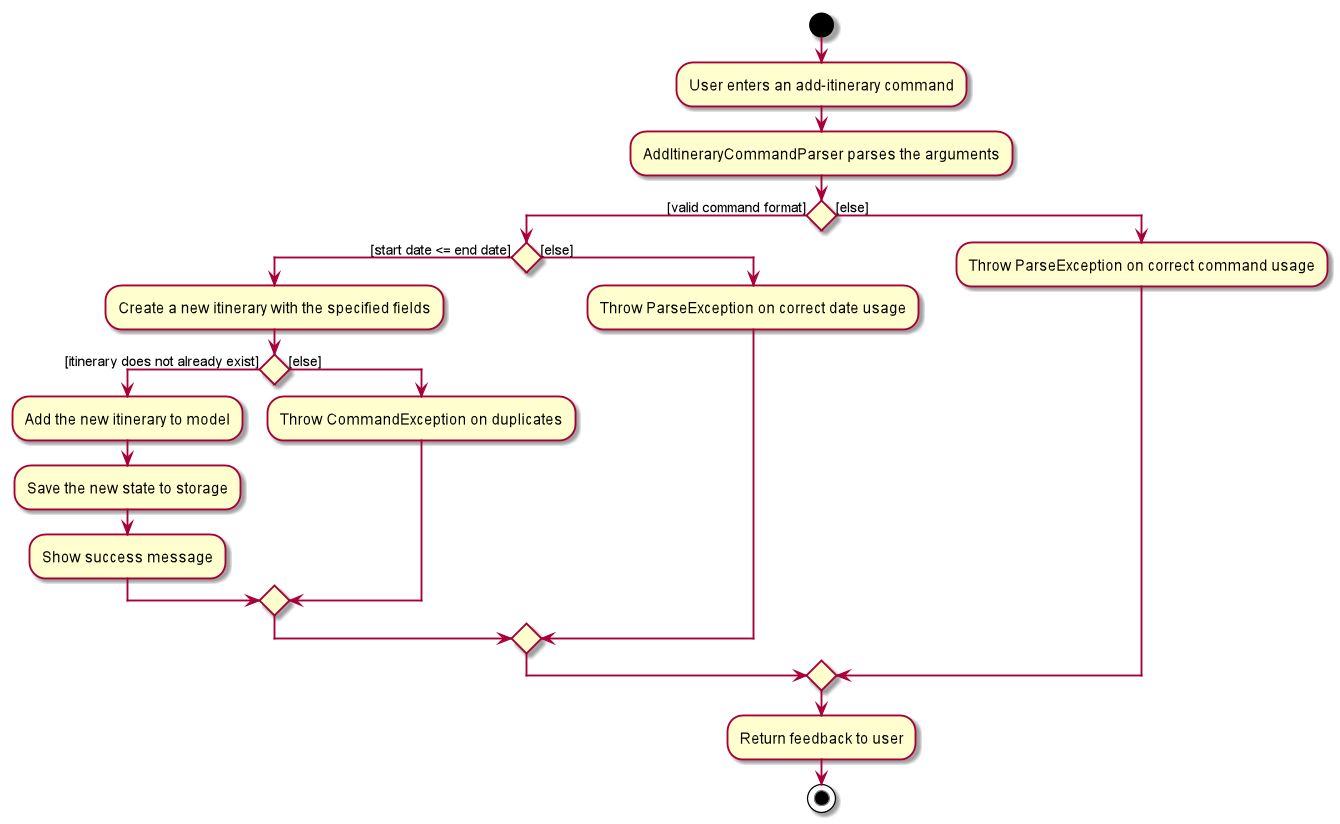
add-itinerary4.5.2 Design Considerations
Aspect: Whether to make start and end date compulsory
-
Alternative 1 (Current choice): Making start and end dates compulsory.
- Pros: Easier to implement and organise
ItineraryAttractions. - Cons: Less flexible for users who do not want to add dates or are unsure of the dates yet.
- Pros: Easier to implement and organise
-
Alternative 2: Making start and end dates optional.
- Pros: More flexible for users who do not want to add dates or are unsure of the dates yet.
- Cons: Requires more functionality to handle adding and deleting the dates. For example, both dates must be either present or absent,
Reason for choosing Alternative 1: Start date and end date must come in pairs. Users accidentally adding or deleting only one of the dates might be frustrated by repeated error messages. Also, we would need to implement additional functionalities to handle how to add attractions with and without dates. For example, we would probably have to handle users adding itinerary attractions with specified days to itineraries without a date range, and determine different ways to store and display itinerary attractions for itineraries without dates. Therefore, we decided to go with the first alternative for a simplified process.
4.6 Edit Itinerary Feature
TrackPad allows users to edit itineraries that have already been added.
Any of the following fields of an itinerary can be edited:
NamestartDateendDateDescriptionBudget
4.6.1 Current Implementation
The EditItineraryCommand class handles the execution of edit itinerary operations. The EditItineraryCommandParser class helps
to parse a user’s input before creating the correct EditItineraryCommand.
TrackPad uses the EditItineraryDescriptor class to facilitate edit operations.
An EditItineraryDescriptor is a temporary bridge that holds the newly-edited fields of an itinerary.
Step 1. The user types in edit-itinerary 1 sd/10-11-2020 to edit the startDate of the first itinerary in the Itineraries panel.
Step 2. LogicManager passes the input to TrackPadParser, which in turn recognises the input as an EditItineraryCommand and passes the input to EditItineraryCommandParser.
Step 3. EditItineraryCommandParser parses the input, constructing a new EditItineraryDescriptor object from the input, containing the updated fields of the itinerary.
Step 4. EditItineraryCommandParser constructs a new EditCommand with the EditItineraryDescriptor object.
Step 5. LogicManager executes the EditItineraryCommand, creating a new editedItinerary object from the fields of the EditItineraryDescriptor object and the target itinerary.
Step 6. This calls Model to replace the target itinerary with the editedItinerary object.
Step 7. After the target itinerary is replaced, EditItineraryCommand returns a CommandResult for the Ui to display.
The following sequence diagram shows how the edit-itinerary operation works:
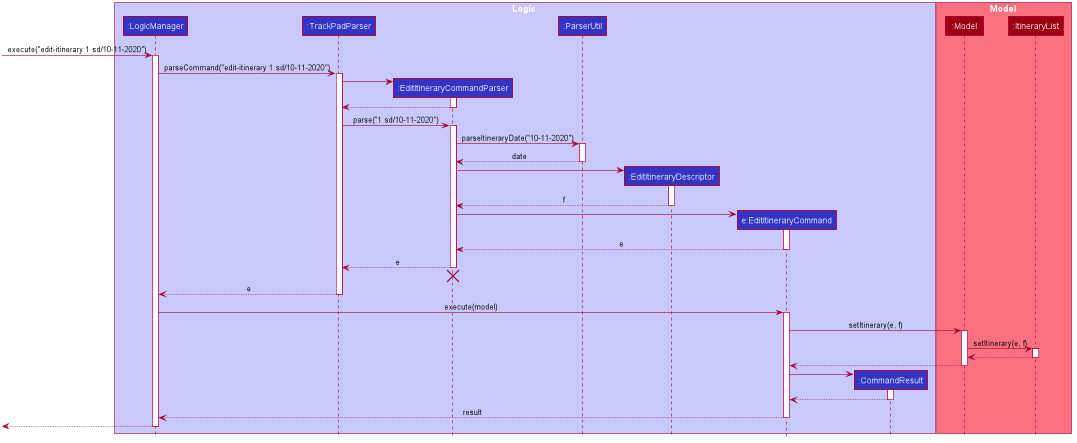
edit-itineraryThe following activity diagram summarizes what happens when a user executes an edit-itinerary command:
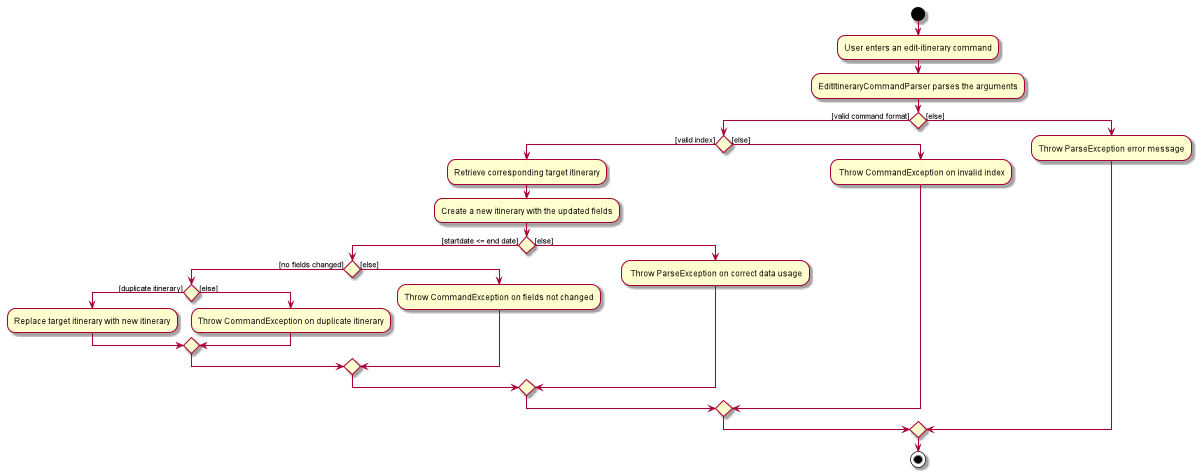
edit-itinerary4.6.2 Design Considerations
Aspect: Using edit-itinerary to edit fields of Itinerary only
-
Alternative 1 (Current choice):
edit-itineraryis only able to edit the fields of the itinerary- Pros: Shorter and simpler
ItineraryAttractioncommands, where the commands only deal with the fields of theItineraryAttractionsand do not access the fields ofItinerary. - Cons: Different set of commands to edit the fields of
ItineraryandItineraryCommands, may not be user friendly.
- Pros: Shorter and simpler
-
Alternative 2:
edit-itineraryis able to edit the fields of theItineraryAttractions- Pros: Lesser commands for the user to deal with.
- Cons: This command could be confusing to users.
Reason for choosing Alternative 1: Takes into account users are more likely to use more ItineraryAttraction commands compared
to EditItinerary commands. It also reduces the complexity of the code in ItineraryAttractions by only dealing with the
fields of ItineraryAttractions and do not access the fields of Itinerary.
4.7 Find Itinerary Feature
The find itinerary feature allows users to find itineraries using keywords.
4.7.1 Current Implementation
The FindItineraryCommand class handles the execution of find itinerary operations. The FindItineraryCommandParser class helps
to parse a user’s input before creating the correct FindItineraryCommand.
Step 1. The user types in find-itinerary Korea to find itineraries with the keyword Korea.
Step 2. LogicManager passes the input to TrackPadParser, which in turn recognises the input as an FindItineraryCommand and passes the input to FindItineraryCommandParser.
Step 3. In FindItineraryCommandParser, the string input is extracted as a predicate and used to create a FindItineraryCommand.
Step 4. This calls Model to filter the itineraries list based on the given predicate.
Step 5. After the itineraries list is replaced, FindItineraryCommand returns a CommandResult for the Ui to display.
The following sequence diagram shows how the find-itinerary operation works:
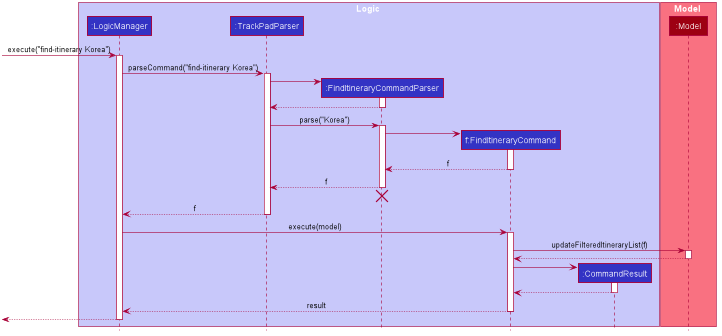
find-itineraryThe following activity diagram summarizes what happens when a user executes an find-itinerary command:
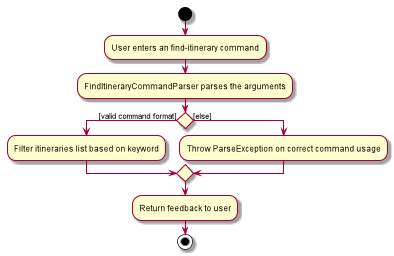
find-itinerary4.7.2 Design Considerations
Aspect: How the command word of find-itinerary is derived
-
Alternative 1 (Current choice):
find-itinerary- Pros: More intuitive, follows the format of the
find-attractioncommand. - Cons: More time spent typing the command.
- Pros: More intuitive, follows the format of the
-
Alternative 2:
find-i- Pros: Simple and faster to type.
- Cons: Less intuitive, users might have to remember the correct command when finding their itineraries.
Reason for choosing Alternative 1: Given that the find command for attractions is find-attraction,
find-itinerary ensures that the command format is consistent and more intuitive to the users.
4.8 Select Itinerary Feature
The select itinerary feature allows users to select itineraries before using ItineraryAttraction commands.
4.8.1 Current Implementation
Step 1. The user types in select-itinerary 2 to select the second itinerary in the Itineraries panel.
Step 2. LogicManager passes the input to TrackPadParser, which in turn recognises the input as an SelectItineraryCommand and passes the input to SelectItineraryCommandParser.
Step 3. In SelectItineraryCommandParser, the string input parsed to an index and used to create a SelectItineraryCommand.
Step 4. The itinerary corresponding to the index is retrieved in SelectItineraryCommand and this calls on Model to set the current itinerary
using the itinerary retrieved.
Step 5. After the itinerary is set, SelectItineraryCommand returns a CommandResult for the Ui to display.
The following sequence diagram shows how the select-itinerary operation works:
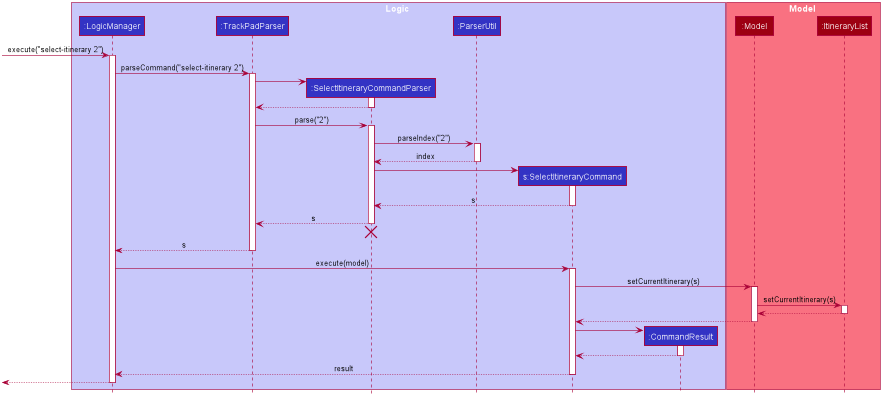
select-itineraryThe following activity diagram summarizes what happens when a user executes an select-itinerary command:
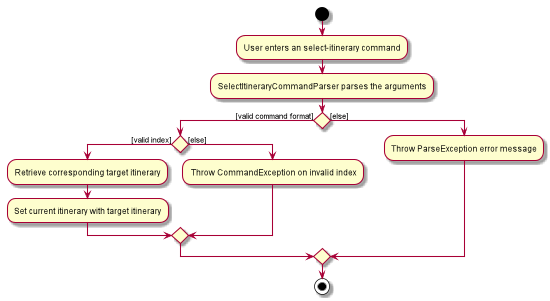
select-itinerary4.8.2 Design Considerations
Aspect: Having select-itinerary as a stand alone command
-
Alternative 1 (Current choice): Use the
select-itinerarycommand to set the current itinerary to performItineraryAttractioncommands.- Pros: Shorter and simpler
ItineraryAttractioncommands. - Cons: Users are unable to edit multiple itineraries at once without switching the target itinerary.
- Pros: Shorter and simpler
-
Alternative 2: Having itinerary attraction commands to specify the target itinerary
- Pros: Users will be able to edit multiple itineraries at once without switching the target itinerary.
- Cons: More complexity of code in the
ItineraryAttractionfeatures having to access both theAttractionandItinerarylists to look for the target attractions and itineraries.
Reason for choosing Alternative 1: Takes into account users are more likely to use more ItineraryAttraction commands
within a single itinerary. It also reduces the complexity of the code in ItineraryAttraction features.
4.9 Itinerary Attraction Model
This is a subclass of Attraction that goes into the List<Day> that resides in Itinerary.
4.9.1 Itinerary Attraction Implementation
ItineraryAttraction extends Attraction. It is a Attraction with 2 extra fields, startTime and endTime.
It is stored internally as an List<Day>. Additionally, it implements the following operations:
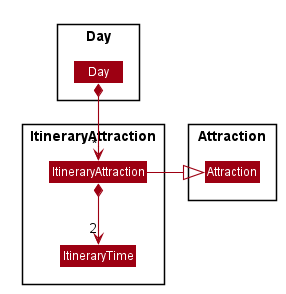
ItineraryAttraction is an Attraction and contains startTime and endTime.
4.9.2 Design Considerations
Aspect: Inheritance or composition
-
Alternative 1 (current choice):
ItineraryAttractioninheritsAttraction.- Pros: Allows it to be treated as an
AttractionallowingItineraryAttractionaccess to getters forAttractionwithout redefining it. - Cons: Does not provide reference to original
Attraction. Changes in originalAttractionis not reflected in thisItineraryAttraction.
- Pros: Allows it to be treated as an
-
Alternative 2:
ItineraryAttractionwould composeAttraction- Pros: Easy to implement by just adding an
Attractionfield. - Cons: Would require many getters to access fields inside
Attraction.
- Pros: Easy to implement by just adding an
Reasons:
- If we choose composition, we would need to
itineraryAttraction.getAttraction().getField(). - If we choose inheritance, we can just do
itineraryAttraction.getField(). - We choose inheritance to allow easier access to fields in an
Attraction.
Aspect: Constructor
-
Alternative 1 (current choice): constructor takes in an
Attraction.- Pros: It is neater and simpler to use attraction as parameter to create an
ItineraryAttractionobject. - Cons: New methods and test cases have to be written to test this behaviour, instead of adapting from
Attraction.
- Pros: It is neater and simpler to use attraction as parameter to create an
-
Alternative 2: constructor takes in all the fields of
Attraction.- Pros: Can reuse codes from attractions.
- Cons: Makes the codes very messy and long.
Reason: Alternative 2 will have higher chances of bugs. Attraction objects are currently passed around instead of the individual fields, so it simplifies and shortens the codes and reduces likelihood of bugs.
4.10 Adding Itinerary Attraction
4.10.1 Adding Itinerary Attraction Implementation
The feature allows users to select an Attraction from the attraction list and add it into their selected itinerary,
with a start and end time.
The following activity diagram shows a simplified add-itinerary-attraction operation:
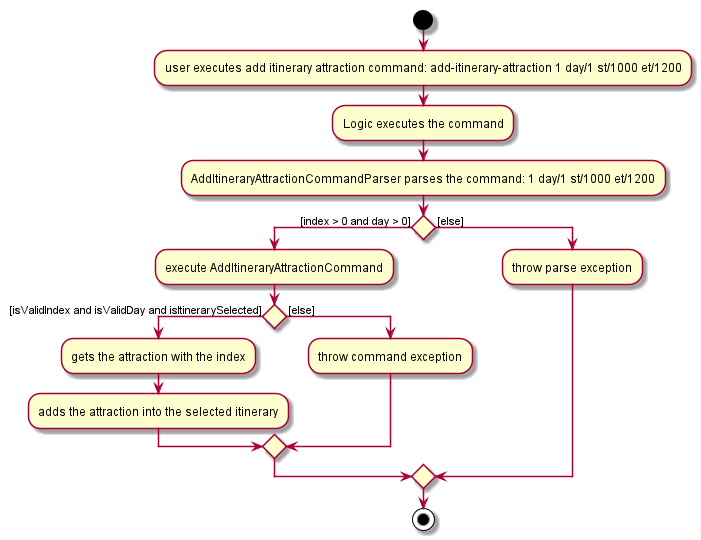
add-itinerary-attractionAssumes:
- The user launches the application.
- Selected a valid itinerary with more than 1 day.
- Attractions lists has more than 1 attractions.
Step 1. The user types in add-itinerary-attraction 1 day/1 st/1000 et/1200 to add a new attraction to the selected
itinerary and the timing does not clash with any exisiting attractions in the itinerary.
Step 2. LogicManager passes the input to TrackPadParser, which in turn recognises the input as an AddItineraryattractionCommand and passes the input to AddItineraryAttractionCommandParser.
Step 3. AddItineraryAttractionCommandParser parses the input and constructs a new AddItineraryAttractionCommand containing a new ItineraryAttraction with the specified fields.
Step 4. LogicManager executes the new AddItineraryAttractionCommand. This calls Model to add the new ItineraryAttraction to the itinerary specified.
Step 5. After the new ItineraryAttraction is successfully added, AddItineraryAttractionCommand returns a CommandResult for the Ui to display.
The following sequence diagram shows how the add-itinerary-attraction operation works:
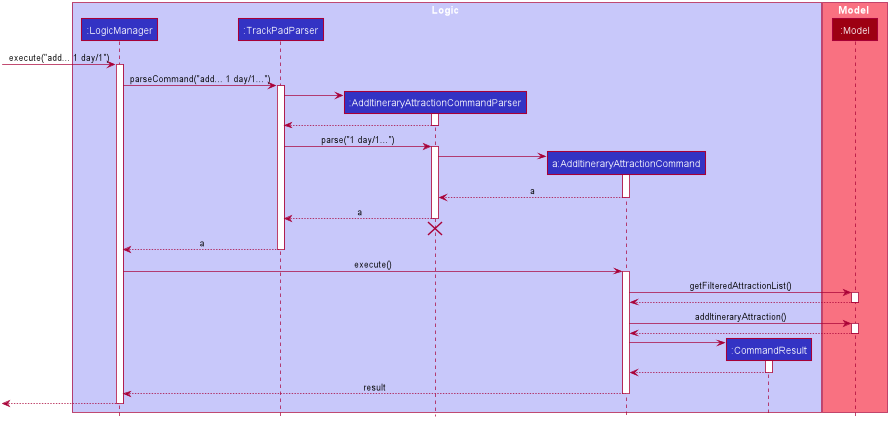
add-itinerary-attraction 1 day/1 st/1000 et/1200.4.10.2 Design Considerations
Aspect: Command keyword
-
Alternative 1 (current choice):
add-itinerary-attractionis used to executeAddItineraryAttractionCommand.- Pros: This command is distinct from the
add-attractioncommand,add-itinerary-attraction, reduces ambiguity. - Cons: It is long command to type and users may be confused with the difference to
add-attraction.
- Pros: This command is distinct from the
-
Alternative 2:
add-attractionis used to executeAddItineraryAttractionCommand.- Pros: This is short and the same as the normal command, users has fewer commands to remember.
- Cons: This command could be confusing to users and could cause careless users to add commands into the attraction lists instead of the itinerary.
Reason: Alternative 2 was not used because TrackPad has no way to know which command the user wants to execute, there is no way to show the command usage should the user type something wrong. As TrackPad’s audience are fast typists, these few words makes little difference to execution speed of the commands. Hence, alternative 1 was implemented.
4.11 UI Model
4.11.1 Current Implementation
The current UI involves many inherited classes from AttractionCard, ItineraryListCard and ItineraryAttractionCard.
This is because TrackPad supports optional fields, and with the current code, the Label in the FXML files will be created regardless
whether the field is filled or not. Thus, it leaves many empty spaces in the GUI if the user adds an attraction without most of the optional fields.
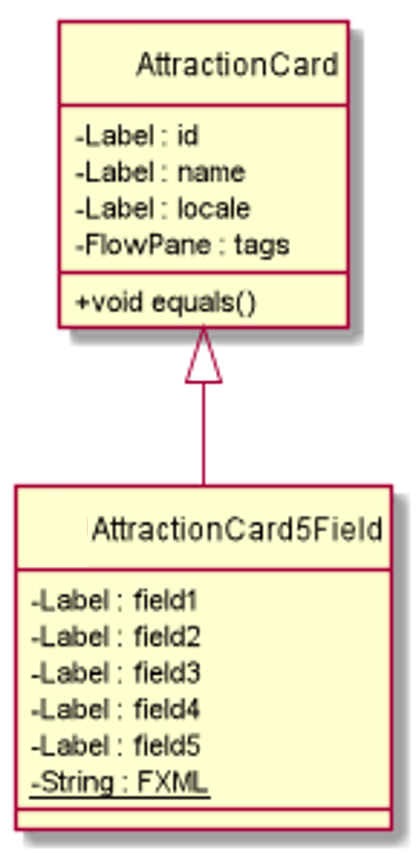
Figure 26 shows an example of the current implementation of the AttractionCard. Compulsory fields, such as name and locale
are present in the parent class since all attractions have those fields. In AttractionListPanel, the number of filled fields
will be determined in the corresponding Attraction, via the getNumOfFilledFields() method, and the appropriate child will be used to
create the card. This way, we can avoid any unnecessary gaps found in the boxes due to missing fields.
4.11.2 Design Considerations
Aspect: Method of Implementation
-
Alternative 1: Only one
AttractionCardis used to create the attraction cards. - Pros: Lesser code required, and no need for so many children classes.
-
Cons: Empty lines will be seen in the GUI.
-
Alternative 2 (Current Choice): Several
AttractionCardchild classes are used to create the corresponding attraction cards. - Pros: Fixes the issue of empty lines being seen, by not creating redundant labels from the different FXML files.
- Cons: Many classes are created. Some code repetition.
Reason for choosing Alternative 2: The final app GUI should look pleasant and attractive to the users. By removing those empty lines, it makes the interface look more neat and organised. However, this is not yet an ideal solution and a better solution could be looked for in the future versions beyond v1.4. A possible combination of the above 2 alternatives could be possible to implement this functionality with less repetitive code.
5. Documentation, logging, testing, configuration, dev-ops
This section shows the various standards TrackPad adheres to.
Appendix A: Product Scope
Target user profile:
- travelholics who love traveling and keeping track of their trips
- travelled to many different places before
- plans to travel to other countries in the future
- has a need to manage a significant number of tourist attractions
- prefer desktop apps over other types
- can type fast
- prefers typing to mouse interactions
- is reasonably comfortable using CLI apps
Value proposition:
- manage information for trips and tourist attractions faster than a typical mouse/GUI driven app
- keeps track of different tourist attractions visited by the user
- allows creation of itineraries to track future travels
- customisable shortcuts that the user can set for frequently used commands
Appendix B: User Stories
Priorities: High (must have) - * * *, Medium (nice to have) - * *, Low (unlikely to have) - *
| Priority | As a … | I want to … | So that I can… |
|---|---|---|---|
* * * |
person planning for my travel | add tourist attractions | keep track of tourist attractions I want to visit |
* * * |
person planning for my travel | delete tourist attractions | remove tourist attractions that I might not want to visit |
* * * |
person planning for my travel | find tourist attractions from my list | quickly search for a specific tourist attraction |
* * * |
person planning for my travel | see a list of all the tourist attractions | get a look at all my tourist attractions at one go |
* * * |
person planning for my travel | clear all tourist attractions from my plan | reset the list of attractions |
* * * |
person planning for my travel | edit the information in my tourist attractions | update my attractions with new information |
| Priority | As a … | I want to … | So that I can… |
|---|---|---|---|
* * * |
person planning for my travel | tag tourist attractions in different categories like food, sightseeing, activities | distinguish between the different kinds of tourist attractions |
* * * |
person planning for my travel | add locations / addresses to my attractions | know where the attraction is located and how to get there |
* * * |
person planning for my travel | add descriptions to my attractions | know roughly what the attraction is about when viewing them |
* * * |
person planning for my travel | add contact details such as email and phone number to my attractions | know how to contact them if I need |
* * * |
new user | find the user guide easily | know what I can do with the app |
* * |
person planning for my travel | create multiple itineraries for different trips | plan for all my different travelling trips |
* * |
person planning for my travel | add descriptions to my itineraries such as trip details | ensure I have all the correct trip information in one place |
* * |
person planning for my travel | add dates to my itineraries | plan when the trip will take place |
| Priority | As a … | I want to … | So that I can… |
|---|---|---|---|
* * |
person planning for my travel | add attractions to my itineraries | plan which attractions to visit |
* * |
person planning for my travel | delete attractions from my itineraries | remove attractions I do not want to visit anymore |
* * |
person planning for my travel | edit attractions in my itineraries | update the attractions I am planning to visit in my itineraries |
* * |
person planning for my travel | specify the times at which I visit an attraction within an itinerary | plan when to visit the attractions |
* * |
new user | see the app with sample data | see what kind of data the app can store |
* |
person planning for my travel | add opening hours to my attractions | know when to visit |
* |
person planning for my travel | add the estimated price range to my attractions | know which attractions to choose to match my budget |
* |
person planning for my travel | add the estimated budget to my itineraries | plan how much to spend on each trip |
| Priority | As a … | I want to … | So that I can… |
|---|---|---|---|
* |
person currently traveling | mark tourist attractions as visited / not visited | know which attractions I missed |
* |
person who had already traveled | give ratings to my attractions | keep track of which tourist attractions were enjoyable |
Appendix C: Use Cases
(For all use cases below, the System is the TrackPad and the Actor is the user, unless specified otherwise)
Use case: UC01 - Add a tourist attraction
MSS
- User requests to add a tourist attraction.
- User provides the fields of the tourist attraction to be added.
-
TrackPad adds the tourist attraction and shows a success message.
Use case ends.
Extensions
-
2a. A field provided for the tourist attraction is invalid.
-
2a1. TrackPad shows an error message.
Use case resumes at step 2.
-
-
2b. The tourist attraction to be added already exists in the list of attractions.
-
2b1. TrackPad shows an error message.
Use case resumes at step 2.
-
Use case: UC02 - Edit a tourist attraction
MSS
- User requests to edit a tourist attraction.
- User provides the index of the tourist attraction to be edited.
- User provides the fields of the tourist attraction to be edited.
-
TrackPad edits the fields and shows a success message.
Use case ends.
Extensions
-
2a. The index provided does not exist in the attractions list.
-
2a1. TrackPad shows an error message.
Use case resumes at step 2.
-
-
3a. The new field provided for the tourist attraction is invalid.
-
3a1. TrackPad shows an error message.
Use case resumes at step 3.
-
-
3b. The new field provided for the tourist attraction is the same as the current one.
-
3b1. TrackPad shows an error message.
Use case resumes at step 3.
-
Use case: UC03 - Delete a tourist attraction
MSS
- User requests to delete a tourist attraction.
- User provides the index of the tourist attraction to be deleted.
-
TrackPad deletes the tourist attraction and shows a success message.
Use case ends.
Extensions
-
2a. The index provided does not exist in the attractions list.
-
2a1. TrackPad shows an error message.
Use case resumes at step 2.
-
Use case: UC04 - Mark a tourist attraction as visited
MSS
- User requests to mark a tourist attraction as visited.
- User provides the index of the tourist attraction to be marked as visited.
-
TrackPad marks the tourist attraction as visited and shows a success message.
Use case ends.
Extensions
-
2a. The index provided does not exist in the attractions list.
-
2a1. TrackPad shows an error message.
Use case resumes at step 2.
-
-
2b. The attraction that corresponds to the inputted index is already visited.
-
2b1. TrackPad shows an error message.
Use case resumes at step 2.
-
Use case: UC05 - Find a tourist attraction
MSS
- User requests to find a tourist attraction.
- User provides the keyword he is looking for.
-
TrackPad shows a list of all the tourist attractions that match the keyword.
Use case ends.
Extensions
-
3a. There are no tourist attractions that matches the keyword.
-
3a1. TrackPad shows an empty list of attractions.
Use case ends.
-
Use case: UC06 - List all tourist attractions
MSS
- User requests to list all tourist attractions.
-
TrackPad shows a list of all tourist attractions.
Use case ends.
Extensions
-
2a. The list is empty.
Use case ends.
Use case: UC07 - Clear all tourist attractions
MSS
- User requests to delete all tourist attractions in the list.
-
TrackPad deletes all tourist attractions in the list.
Use case ends.
Extensions
-
2a. The list is empty.
Use case ends.
Use case: UC08 - Add an itinerary
MSS
- User requests to add an itinerary.
- User provides the fields of the itinerary to be added.
-
TrackPad adds the itinerary.
Use case ends.
Extensions
-
2a. The given format for the itinerary is invalid.
-
2a1. TrackPad shows an error message.
Use case resumes at step 2.
-
-
2b. The itinerary already exists in the list of itineraries.
-
2b1. TrackPad shows an error message.
Use case resumes at step 2.
-
Use case: UC09 - Edit an itinerary
MSS
- User requests to list itineraries.
- TrackPad shows a list of itineraries.
- User requests to edit a specific itinerary in the list.
-
TrackPad edits the itinerary.
Use case ends.
Extensions
-
2a. The list is empty.
Use case ends.
-
3a. The format is invalid.
-
3a1. TrackPad shows an error message.
Use case resumes at step 3.
-
-
3b. The given index is invalid.
-
3b1. TrackPad shows an error message.
Use case resumes at step 3.
-
-
3c. The new field(s) provided for the itinerary is the same as the current one.
-
3c1. TrackPad shows an error message.
Use case resumes at step 3.
-
Use case: UC10 - Delete an itinerary
MSS
- User requests to list itineraries.
- TrackPad shows a list of itineraries.
- User requests to delete a specific itinerary in the list.
-
TrackPad deletes the itinerary.
Use case ends.
Extensions
-
2a. The list is empty.
Use case ends.
-
3a. The given index is invalid.
-
3b. TrackPad shows an error message.
Use case resumes at step 3.
-
Use case: UC11 - Find an itinerary
MSS
- User requests to find an itinerary.
-
TrackPad shows a list of itineraries matching the keyword entered.
Use case ends.
Extensions
-
2a. The list is empty.
Use case ends.
-
3a. The given keyword is not found.
-
3a1. TrackPad shows an error.
Use case ends.
-
Use case: UC12 - List all itineraries
MSS
- User requests to list all itineraries.
-
TrackPad shows a list of all itineraries.
Use case ends.
Extensions
-
2a. The list is empty.
Use case ends.
Use case: UC13 - Select an itinerary
MSS
- User requests to list itineraries.
- TrackPad shows a list of itineraries.
- User requests to select a specific itinerary in the list.
-
TrackPad selects the itinerary.
Use case ends.
Extensions
-
2a. The list is empty.
Use case ends.
-
3a. The given index is invalid.
-
3a1. TrackPad shows an error message.
Use case resumes at step 2.
-
Use case: UC14 - Clear all itineraries
MSS
- User requests to delete all itineraries in the list.
-
TrackPad deletes all itineraries in the list.
Use case ends.
Extensions
-
2a. The list is empty.
Use case ends.
Use case: UC15 - Add a tourist attraction into selected itinerary
MSS
- User selects an itinerary (UC13).
- User requests to add an attraction into the selected itinerary.
- User provides the fields of the attraction to be added.
-
TrackPad adds the tourist attraction into the selected itinerary and shows a success message.
Use case ends.
Extensions
-
3a. A field provided for the tourist attraction is invalid.
-
3a1. TrackPad shows an error message.
Use case resumes at step 3.
-
-
3b. The attraction added has conflicting timing in the itinerary.
-
3b1. TrackPad shows an error message.
Use case resumes at step 3.
-
Use case: UC16 - Edit a tourist attraction in selected itinerary
MSS
- User selects an itinerary (UC13).
- User requests to edit a tourist attraction in the selected itinerary.
- User provides the index and day of the tourist attraction to be edited.
- User provides the fields of the tourist attraction to be edited.
-
TrackPad edits the fields and shows a success message.
Use case ends.
Extensions
-
3a. The index or day provided does not exist in the selected itinerary.
-
3a1. TrackPad shows an error message.
Use case resumes at step 3.
-
-
4a. The new field provided for the tourist attraction is not in the correct format.
-
4a1. TrackPad shows an error message.
Use case resumes at step 4.
-
-
4b. The new field provided for the tourist attraction is the same as the current one.
-
4b1. TrackPad shows an error message.
Use case resumes at step 4.
-
Use case: UC17 - Delete a tourist attraction in selected itinerary
MSS
- User selects an itinerary (UC13).
- User requests to delete a tourist attraction from the selected itinerary.
- User provides the index and day of the tourist attraction to be deleted.
-
TrackPad deletes the tourist attraction and shows a success message.
Use case ends.
Extensions
-
3a. The index and day provided does not exist in the itinerary.
-
3a1. TrackPad shows an error message.
Use case resumes at step 3.
-
Use case: UC18 - Viewing help
MSS
- User requests for help in TrackPad.
- User provides the command for help
-
TrackPad directs the user to TrackPad user guide.
Use case ends.
Extensions
-
2a. There is a typo in the command.
-
2a1. TrackPad shows an error message.
Use case resumes at step 2.
-
Use case: UC19 - Exiting the program
MSS
- User wishes to exit TrackPad.
- User enters the command to exit.
-
TrackPad closes.
Use case ends.
Extensions
-
2a. User clicks the exit button on the top right of the window.
Use case resumes at step 3.
-
2b. User clicks the exit button, located under the File tab.
Use case resumes at step 3.
Use case: UC20 - Saving the data
MSS
- User wishes to save current data in TrackPad.
- User enters any valid command.
-
Data in TrackPad is updated and saved.
Use case ends.
Extensions
-
2a. User enters an invalid command.
Use case ends.
-
*a. At any time, user chooses to terminate and close the program.
Use case resumes at step 3.
Appendix D: Non-Functional Requirements
- The product should be able to hold up to 1000 tourist attractions/itineraries/days without a noticeable sluggishness in performance for typical usage.
- A user with above average typing speed for regular English text (i.e. not code, not system admin commands) should be able to accomplish most of the tasks faster using commands than using the mouse.
- The user interface should be intuitive enough for users who are not IT-savvy.
- The product is not required to recommend new tourist attractions which are not inputted by the user.
- The product should be free to download and use.
- The system should work on any mainstream OS as long as it has Java
11or above installed. - The system should work on both 32-bit and 64-bit environments.
- The system should respond within five seconds.
- The project is expected to be a brown-field project.
- The progress of the project is expected to adhere to the schedule provided on the module website.
Appendix E: Glossary
- Mainstream OS: Windows, Linux, Unix, OS-X
Appendix F: Instructions for Manual Testing
Given below are instructions to test the app manually.
F1 Launch and shutdown
-
Initial launch.
-
Download the jar file and copy into an empty folder.
-
Double-click the jar file Expected: Shows the GUI with a set of sample contacts. The window size may not be optimum.
-
-
Saving window preferences.
-
Resize the window to an optimum size. Move the window to a different location. Close the window.
-
Re-launch the app by double-clicking the jar file.
Expected: The most recent window size and location is retained.
-
F2 Adding a tourist attraction
-
Adding a tourist attraction.
-
Prerequisites: No attraction in TrackPad has both the name ‘Zoo’ and the location ‘Singapore’.
-
Test case:
add-attraction n/Zoo l/Singapore
Expected: New attraction added to the bottom of the attractions list. Details of the added attraction shown in the status message. -
Test case:
add-attraction n/Zoo
Expected: No attraction added. Error details shown in the status message. -
Other incorrect add-attraction commands to try:
add-attraction n/Zoo l/Singapore p/+6591234567,add-attraction n/NAME l/LOCATION(where both the NAME and LOCATION are the same as another attraction in TrackPad)
Expected: Similar to previous.
-
F3 Editing a tourist attraction
-
Editing a tourist attraction while all the attractions in TrackPad are shown in the attractions list.
-
Prerequisites: List all attractions using the
list-attractioncommand. -
Test case:
edit-attraction 1 p/999
Expected: Phone number of first attraction edited to 999. Details of the edited attraction shown in the status message. -
Test case:
edit-attraction 0 p/999
Expected: No attraction edited. Error details shown in the status message. -
Other incorrect edit-attraction commands to try:
edit-attraction 1 r/5.1,edit-attraction 1 n/NAME(where NAME is the same as the current name of the first attraction)
Expected: Similar to previous.
-
F4 Deleting a tourist attraction
-
Deleting a tourist attraction while all the attractions in TrackPad are shown in the attractions list.
-
Prerequisites: List all attractions using the
list-attractioncommand. -
Test case:
delete-attraction 1
Expected: First attraction deleted from the list. Details of the deleted attraction shown in the status message. -
Test case:
delete-attraction 0
Expected: No attraction deleted. Error details shown in the status message. -
Other incorrect delete-attraction commands to try:
delete-attraction,delete-attraction x(where x is larger than the list size)
Expected: Similar to previous.
-
F5 Marking an attraction as Visited
-
Marking an attraction as Visited while all attractions are being shown
-
Prerequisites: There is at least one attraction present in the attraction list of TrackPad.
-
Test case:
markVisited-attraction 1-
Scenario 1: First attraction does not have the purple Visited tag.
Expected: First attraction marked as visited on the list. Details of the attraction shown in the status message. -
Scenario 2: First attraction already has the purple Visited tag.
Expected: First attraction remains unchanged. Error message shown in the result box.
-
-
Test case:
markVisited-attraction 0
Expected: No attraction marked as visited. Error details shown in the result box. -
Other incorrect markVisited commands to try:
markVisited-attraction,markVisited-attraction x(where x is larger than the list size, or less than 0)
Expected: Similar to previous.
-
F6 Finding a tourist attraction
-
Finding a tourist attraction while all the attractions in TrackPad are shown in the attractions list.
-
Prerequisites: List all attractions using the
list-attractioncommand. Attractions Jurong Bird Park and Snow City are in the attractions list. -
Test case:
find-attraction jurong
Expected: Attractions Jurong Bird Park and Snow City shown in the attractions list. Number of attractions listed shown in the status message. -
Test case:
find-attraction #$%
Expected: Empty attractions list shown. “0 attractions listed!” shown in the status message.
-
F7 Listing attractions
-
Listing all attractions currently stored in TrackPad
-
Prerequisites: None.
-
Test case:
list-attraction
Expected: All attractions that are currently stored in the app will be displayed in the Attractions panel. -
Test case:
list-attraction 1
Expected: Everything typed after the space following the command will be ignored, and list-attraction command will be executed successfully.
-
F8 Clearing attractions
-
Clears all attractions currently stored in TrackPad
-
Prerequisites: None.
-
Test case:
clear-attraction
Expected: All attractions that are currently stored in the app will be deleted. An empty attractions panel will be shown. -
Test case:
clear-attraction 1
Expected: Everything typed after the space following the command will be ignored, and clear-attraction command will be executed successfully.
-
F9 Adding an itinerary
-
Adding an itinerary
-
Prerequisites: No itinerary in TrackPad has the name
Thailand Trip, start date01-08-2020and end date03-08-2020. -
Test case:
add-itinerary n/Thailand Trip sd/01-08-2020 ed/03-08-2020
Expected: An itinerary with the specified name, start date and end date added to the itinerary list. Details of the added itinerary shown in the status message. -
Test case:
add-itinerary
Expected: No itinerary added. Error details shown in the status message. -
Other incorrect add itinerary commands to try:
- Missing compulsory fields (e.g. missing end date):
add-itinerary n/Germany sd/03-02-2020 b/100
Expected: Similar to 3. - Invalid format for fields (e.g. invalid start date format):
add-itinerary n/Germany sd/03 02 2020 ed/06-02-2020
Expected: Similar to 3.
- Missing compulsory fields (e.g. missing end date):
-
F10 Editing an itinerary
-
Editing an itinerary
-
Prerequisites: At least one itinerary exists for editing.
-
Test case:
edit-itinerary 1 n/Japan trip
Expected: The name of the first itinerary changed toJapan trip. Details of the edited itinerary shown in the status message. -
Test case:
edit-itinerary 0 n/Japan trip
Expected: No itinerary edited. Error details shown in the status message. -
Other incorrect edit itinerary commands to try:
- Missing fields:
edit-itinerary 1
Expected: Similar to 3. - Invalid format for fields (e.g. invalid start date format):
edit-itinerary 1 sd/03 02 2020
Expected: Similar to 3. - No change in fields:
edit-itinerary 1 n/Germanywhen the name is alreadyGermany
Expected: Similar to 3.
- Missing fields:
-
F11 Deleting an itinerary
-
Deleting an itinerary while all the itineraries in TrackPad are shown in the itineraries list
-
Prerequisites: List all itineraries using the
list-itinerarycommand. Multiple itineraries in the list. -
Test case:
delete-itinerary 1
Expected: First itinerary deleted from the list. Details of the deleted itinerary shown in the status message. -
Test case:
delete-itinerary 0
Expected: No itinerary deleted. Error details shown in the status message. -
Other incorrect delete commands to try:
- Missing index:
delete-itinerary
Expected: Similar to 3 - Invalid index:
delete-itinerary x, where x is larger than the list size
Expected: Similar to 3
- Missing index:
-
F12 Finding an itinerary
-
Finding an itinerary
-
Prerequisites: TrackPad contains an itinerary with the name
Singapore Tour. No other itinerary containsSingapore Tour. -
Test case:
find-itinerary Singapore Tour
Expected: The itinerary with the nameSingapore Tourfound. -
Test case:
find-itinerary
Expected: No itinerary found. Error details shown in the status message.
-
F13 Listing itineraries
-
Listing all itineraries currently stored in TrackPad
-
Prerequisites: None.
-
Test case:
list-itinerary
Expected: All itineraries that are currently stored in the app will be displayed in the Itineraries panel. -
Test case:
list-itinerary 3
Expected: Everything typed after the space following the command will be ignored, and list-itinerary command will be executed successfully.
-
F14 Selecting an itinerary
-
Selecting an itinerary while all itineraries are being shown
-
Prerequisites: List all itineraries using the
list-itinerarycommand. Multiple itineraries in the list. -
Test case:
select-itinerary 1
Expected: First itinerary is selected from the list. Details of the selected itinerary shown in the status message. -
Test case:
select-itinerary 0
Expected: No itinerary is selected. Error details shown in the status message. -
Other incorrect select commands to try:
- Missing index:
select-itinerary
Expected: Similar to 3 - Invalid index:
select-itinerary x, where x is larger than the list size
Expected: Similar to 3
- Missing index:
-
F15 Clearing itineraries
-
Clears all itineraries currently stored in TrackPad
-
Prerequisites: None.
-
Test case:
clear-itinerary
Expected: All itineraries that are currently stored in the app will be deleted. An empty Itineraries panel will be shown. -
Test case:
clear-itinerary 2
Expected: Everything typed after the space following the command will be ignored, and clear-itinerary command will be executed successfully.
-
F16 Adding an attraction into itinerary
-
Adding an attraction into an itinerary
- Prerequisites:
- At least 1 attraction in attractions lists.
- At least 1 itinerary in itineraries lists.
- An Itinerary must be selected using the
select-itinerary 1command.
- Test case:
add-itinerary-attraction 1 day/1 st/1000 et/1400-
Scenario 1: First attraction of day 1 also happened somewhere between 1000H - 1400H.
Expected: Error message warning of timing clash between the 2 attractions. -
Scenario 2: Day 1 of itinerary between 1000H - 1400H is empty.
Expected: Adds attraction into the selected itinerary. Details of the added attraction shown in the status message.
-
-
Test case:
add-itinerary-attraction
Expected: No attraction added. Error details shown in the status message. - Other incorrect add itinerary attraction commands to try:
- Missing compulsory fields (e.g. missing end time):
add-itinerary-attraction 1 day/1 st/1000
Expected: Similar to 3. - Invalid format for fields (e.g. not a valid time):
add-itinerary-attraction 1 day/1 st/1000 et/2400
Expected: Similar to 3.
- Missing compulsory fields (e.g. missing end time):
- Prerequisites:
F17 Editing an attraction in an itinerary
-
Editing an existing attraction in an itinerary.
-
Prerequisites: Same as F16.
-
Test case:
edit-itinerary-attraction 1 day/1 op/1000-1100
Expected: Change the opening time of the first attraction in the selected itinerary to1000-1100. -
Test case:
edit-itinerary-attraction 2 dayExpected: No attraction edited. Error details shown in the error message. -
Other incorrect edit itinerary attraction commands to try:
- Missing fields:
edit-itinerary-attraction 2 day/3Expected: Similar to 3. - Invalid format (e.g. invalid opening time format):
edit-itinerary-attraction 1 day/1 op/1200 to 1300
Expected: Similar to 3. - No change in fields:
edit-itinerary-attraction 1 day/2 st/1000when the start time is already1000
Expected: Similar to 3.
- Missing fields:
-
F18 Deleting an attraction from an itinerary
-
Deleting an attraction in an itinerary.
-
Prerequisites: Same as F16.
-
Test case:
delete-itinerary-attraction 1 day/2
Expected: Deletes first attraction of day 1 is deleted from the itinerary. -
Other incorrect delete commands to try:
- Missing index:
delete-itinerary-attraction day/2
Expected: No attraction deleted. Error details shown in the error message. - Invalid index:
delete-itinerary-attraction NaN day/2Expected: Similar to previous. - Missing day:
delete-itinerary-attraction 1
Expected: Similar to previous. - Invalid day:
delete-itinerary-attraction 1 day/NaNExpected: Similar to previous.
- Missing index:
-
F19 Viewing help
-
Viewing help
-
Prerequisites: None.
-
Test case:
help
Expected: TrackPad shows a dialog box with a working url to TrackPad’s online user guide. -
Test case:
help uselessString
Expected: TrackPad still shows a dialog box, ignores the extra string after help.
-
F20 Exiting the program
-
Exits and shutdowns the program
-
Prerequisite: None.
-
Test case:
exit
Expected: TrackPad shuts down.
-
F21 Saving data
-
Dealing with missing data files
-
Prerequisites: Launch TrackPad, enter at least one valid command, then exit the app.
-
Test case: In the folder where you saved the app, go to the
datafolder. Deleteattractionlist.json. Launch TrackPad again.
Expected behavior: TrackPad launches with a sample list of attractions to replace the missing attractions file. After entering a valid command, a newattractionlist.jsonfile with the current attractions will be created. -
Test case: In the folder where you saved the app, go to the
datafolder. Deleteitinerarylist.json. Launch TrackPad again.
Expected behavior: TrackPad launches with a sample list of itineraries to replace the missing itineraries file. After entering a valid command, a newitinerarylist.jsonfile with the current itineraries will be created.
-
-
Dealing with corrupted data files
-
Prerequisites: Launch TrackPad, enter at least one valid command, then exit the app.
-
Test case: In the folder where you saved the app, go to the
datafolder. Openattractionlist.json, delete some portions of it and save. Launch TrackPad again.
Expected behavior: TrackPad launches with an empty list of attractions to replace the corrupted attractions file. After entering a valid command, a newattractionlist.jsonfile with the current attractions will be created. -
Test case: In the folder where you saved the app, go to the
datafolder. Openitinerarylist.json, delete some portions of it and save. Launch TrackPad again.
Expected behavior: TrackPad launches with an empty list of itineraries to replace the corrupted itineraries file. After entering a valid command, a newitinerarylist.jsonfile with the current itineraries will be created.
-
Appendix G: Effort
Our project was harder than Address Book Level 3(AB3) because while AB3 deals with one entity, TrackPad deals with several entities, including Attractions, Itineraries as well as Itinerary Attractions.
Initially, we had to refactor most of the code to change all instances of Person to Attraction and AddressBook to TrackPad. We also had to change the test cases, and since we were still unfamiliar with the many lines of code AB3 had, we had a hard time figuring out why some of them failed.
After which, we had to implement Itinerary into the app and make it work similarly enough to Attraction, but still function differently from it. We spent much time and effort deciding on how itineraries, and the attractions they contain are supposed to work and the fields they should have, which resulted in our current implementations of Itinerary and ItineraryAttraction. With the new additions, quite some time was spent on deciding which command words we want to use for each new command, since the new commands can sound similar to existing ones. Afterwards, we had to more than double the number of Command classes and their parsers to support the new commands, and also add many test cases to ensure their correctness. All of these took out a lot of our time and effort in implementing.
In addition, the Ui had to be able to retrieve itinerary attractions. And this has to be done in a different way from attractions and itineraries, since there is one global list for attractions and itineraries, but there are multiple lists of itinerary attractions. This mean time and effort had to be spent in figuring out a new way of sending this information to the UI panels. The itinerary panel also had to be able to switch to itinerary attractions panel, and switch back whenever the appropriate command was called, so this was not easy to implement too.